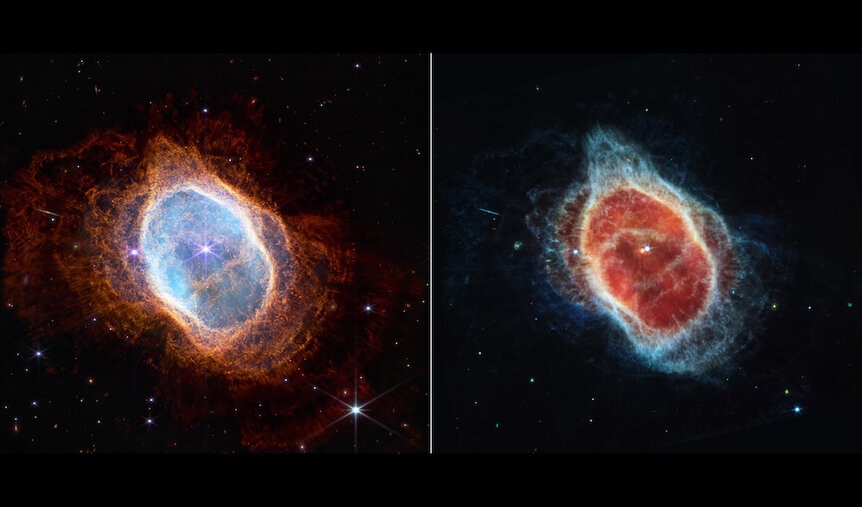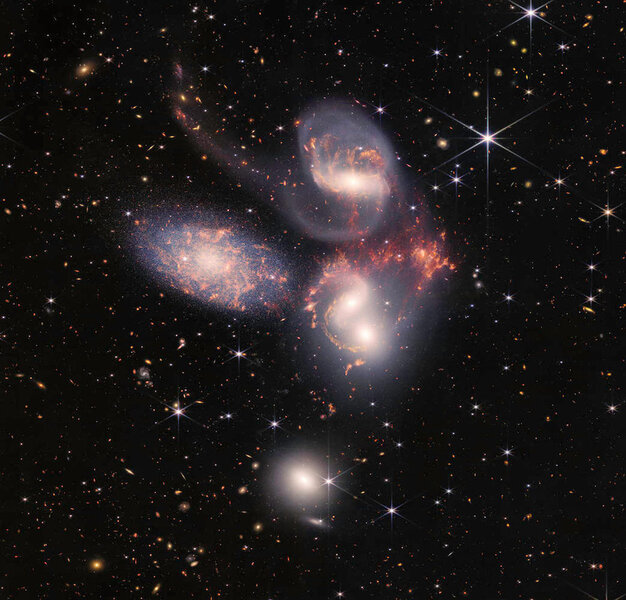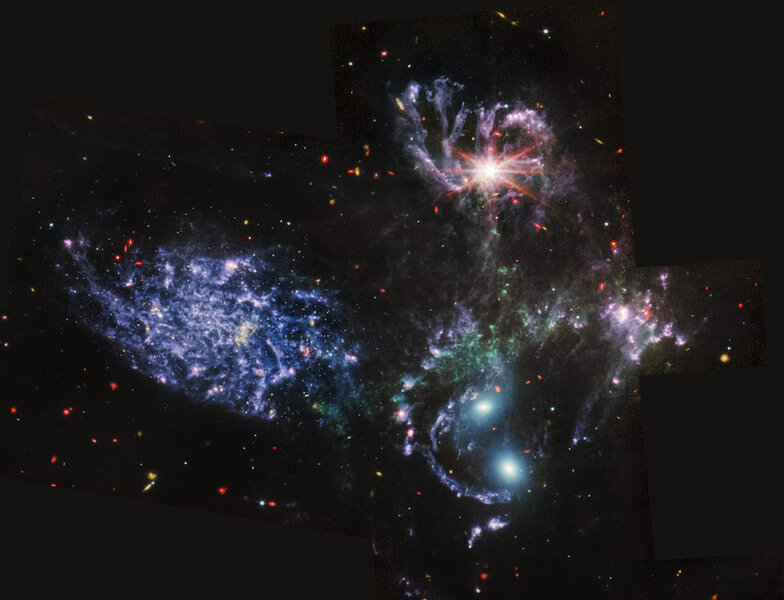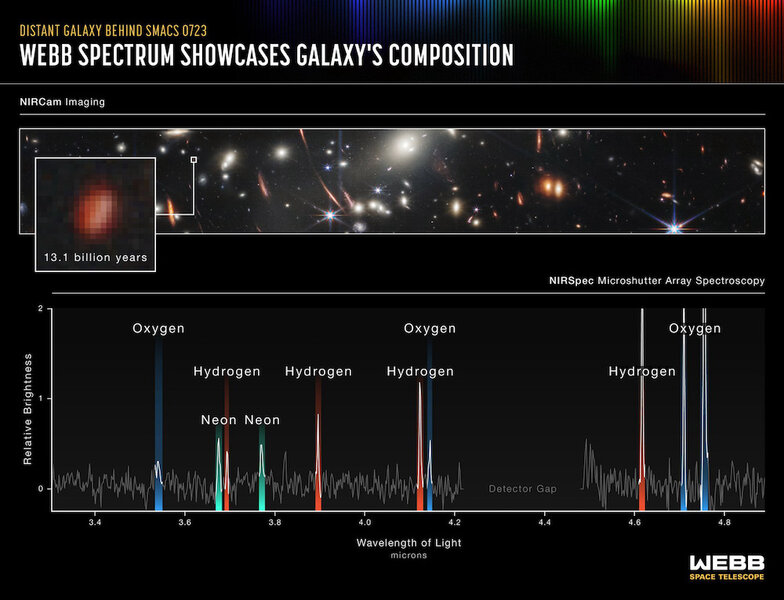The first JWST images of the infrared sky are here and they do *not* disappoint
My God. It’s full of… the Universe.
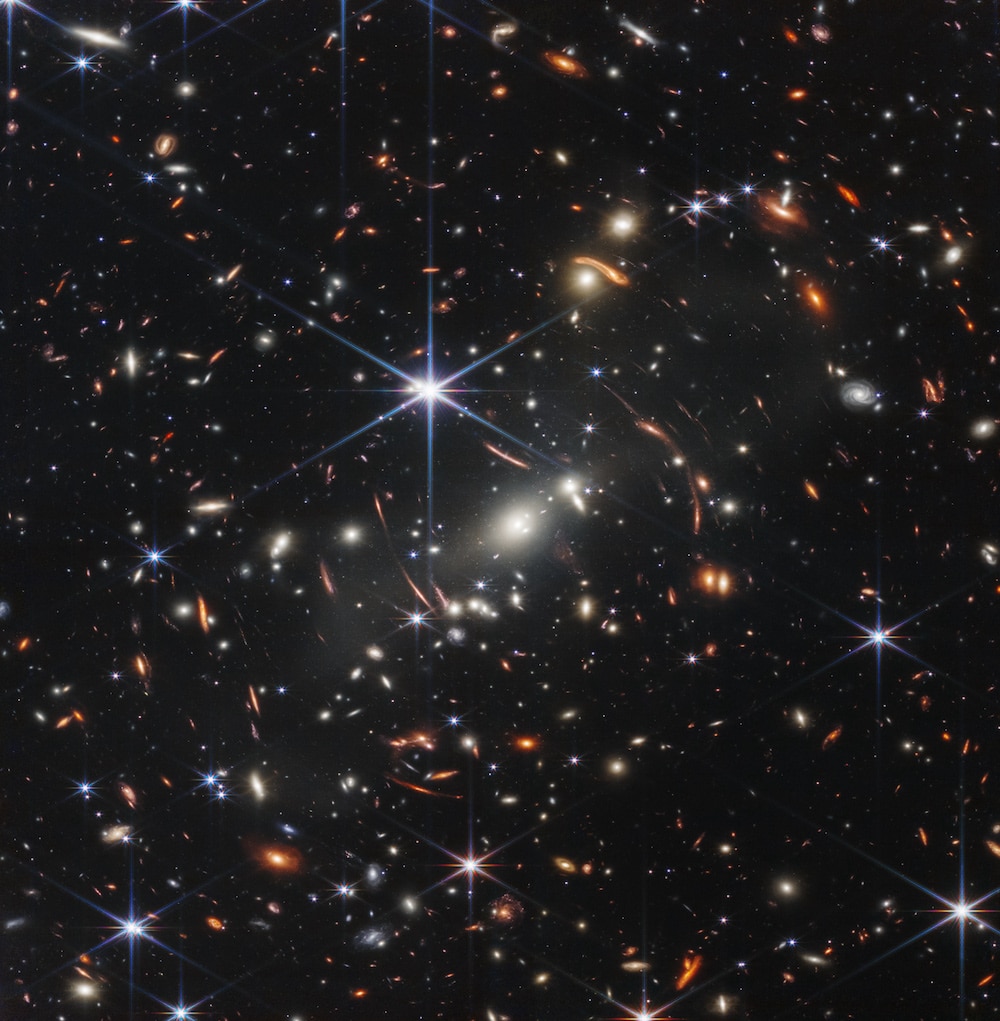
They're here! After 25+ years of designing, planning, building, launching, unfolding, and testing, the first science images from JWST have been released, and reveal the full promise and spectacular nature of what this mighty observatory can achieve*.
JWST is an infrared telescope, meaning it's designed to see light with wavelengths longer than our eyes can perceive. This is important for astronomy: For example, warm objects emit infrared light, and that includes things like dust scattered between stars, planets, brown dwarfs, and more, so we'll have a better view of these than ever before. Distant galaxies at the edge of the observable Universe are swept away from us by the expansion of the Universe, their light redshifted into the infrared part of the spectrum, so that means JWST will see them clearly and provide us with the best data we've ever had on them.
The huge 6.5-meter mirror, made up of 18 hexagonal smaller gold-plated mirrors, gathers a huge amount of light and provides a sharp view of the cosmos, so the images are clean and high-resolution, and the battery of filters means we can convert them into color images to please our eyes and inform our brains.
And hey, your eyes and brain are waiting. Let's go!
NGC 3132, The Southern Ring Nebula
NGC 3132 is a planetary nebula, the gas and dust ejected away from a star that was once much like the Sun but then ran out of fuel in its core and died. The central star expanded into a red giant, blew away thick layers of material, then exposed its hot core which then blew less dense but hotter and faster gas into that previously ejected stuff. This carved a huge expanding bubble into it.
The outer material made of cool molecular gas and dust can be seen in the NIRCAM (Near-Infrared Camera) image in orange, thick and highly structured as the material expands. The hotter ionized gas, called a plasma, is seen filling the cavity in blue. The MIRI (Mid-Infrared Instrument) camera shows longer wavelengths, and the biggest reveal is that the star in the center is actually two stars, a binary system. The second star is buried in so much material it's not visible in shorter wavelengths.
The binary motion may be what shaped this nebula, their orbits around each other sculpting the way the gas was ejected. These JWST image will help astronomers understand the circumstances under which stars like the Sun die — they blow octillions of tons of material back out into the galaxy, which then can be incorporated into newly forming stars. Here we see the death of a star, but it also shows how it helps the next generation of stars be born.
Stephan's Quintet
300 million light-years from Earth is Stephan's Quintet, a small clutch of interacting galaxies… well, four of them are. The fifth, NGC 7320 (left) is actually a foreground galaxy coincidentally aligned with the more distant group.
The NIRCAM image shows cool gas and dust in the group, including some flung out NGC 7318 a and b (center), two galaxies deep in the process of colliding. The gravity of the two galaxies can send out streamers of material, called tidal tails, which then cools and forms stars.
The MIRI image shows something more: The center of NGC 7139 (top) is very bright, and that means we're seeing the tremendous light from a supermassive black hole, eagerly gobbling down gas and dust in the galaxy's core. That material heats up and glows fiercely as it falls in. Images like this (and spectra) can tell astronomers vast amounts about this process, like how massive the black hole is, how much material it's eating, what happens to that matter as it falls in, and how some of it is blasted away in long, thin beams or jets that can fly away from the black hole at speeds a decent fraction of the speed of light!
WASP-96b
1,100 or so light-years from Earth is a Sun-like star, but it has a very un-solar-system-like exoplanet orbiting it. That planet is WASP-96b, a hot Jupiter with about the same size as our own Jupiter, but half the mass, and it orbits the star once every 3.4 days at a distance of only about 7million kilometers!
The top of the atmosphere of WASP-96b is scorching, around 1,000° C (1,800°F). The planet passes in front of the star once per orbit as seen from Earth, an event called a transit. Here's the fun bit: The light from the star passes through the planet's upper atmosphere on its way to Earth. Atoms and molecules in the planet's air absorb very specific wavelengths of that light. So, if we take a spectrum of that light, breaking it up into hundreds or thousands of colors, we can see those narrow dips in the brightness caused by the planet's atmospheric constituents, revealing its composition.
WASP-96b was chosen specifically because it lacks clouds, allowing us to peer more deeply into its atmosphere. JWST did just that, and the spectrum taken reveals the presence of water vapor in the planet's atmosphere! The dips in the spectrum are where hot water — steam — absorbs infrared light. It tells us not only that it's there, but how much is there. Not only that, but the dips don't quite match the models of a cloudless atmosphere, meaning there are some clouds in the sky of WASP-96b, as well as haze — tiny particles suspended in the atmosphere.
We've seen spectra of transiting hot exoplanets before, but none anywhere near this detail in the infrared. Further spectra of other planets will reveal more information, like the presence or lack thereof of things like silicates (rocky material), methane, and more. This process should also work with smaller planets, though it's more difficult. Future observations could reveal what's going on in the atmospheres of planets more like the one we live on, but orbiting stars trillions or quadrillions of kilometers away.
Carina Nebula
In the southern constellation of Carina is a ridiculously huge, sprawling cloud of gas and dust called the Carina Nebula. It's very roughly 7,000 light-years from Earth, and one of the Milky Way's most active star-forming factories.
In this JWST NIRCAM image you can see a handful of very massive, luminous stars at the top. These blast out radiation and winds of subatomic particles that eat away at the gas and dust, evaporating them. This leaves behind a wall of material — that bright, scalloped horizontal line — with dense material below and less dense, hotter material above. It looks almost like a mountainous ridge or, appropriately, a cloudbank.
In the MIRI image we can see the effects of this: Dozens of stars are being born there, some blowing away their birth gas, others still deeply enshrouded in the materials that are forming them.
We understand a lot about star birth, but the devil's in the details. High-resolution images like these will help us see the bulk process better, and infrared spectra of the individual stars will yield vast amounts of information about how stars first switch on, what happens to the material around them when they do, and how some of that material will form planets.
SMACS 0723
The first JWST Deep Field image shows SMACSJ0723.3−7327: a galaxy cluster, a collection of hundreds of galaxies orbiting their mutual center of gravity. It lies very roughly 4.5 billion light-years from Earth.
Now mind you, this image is a little confusing. The sharp objects with diffraction spikes are all stars in our own Milky Way galaxy, probably hundreds or thousands of light years away. But every fuzzy thing you see? Those are entire galaxies, all likely billions of light years away. And there are thousands of them in this image.
Thousands.
Here's the fun part: Only some of those are part of the SMACSJ0723.3−7327 cluster! The whitish, roughly circular blobs are part of the cluster. But you can also see dozens of elongated galaxies, curved into arcs or smeared out into slug-like structures. Those are far more distant galaxies, well behind the cluster as seen from Earth.
The combined mass of the galaxies in the cluster warps the light coming from objects behind it, magnifying their size and amplifying their brightness in a process called gravitational lensing. That can draw them out like taffy, making them look like arcs. But the individual galaxies in the cluster further bend and distort the shapes, so some are even weirder shapes.
The beauty of this is that those more distant galaxies may be too dim to see without the lensing effect, so many of these galaxies are much, much farther away than we could normally observe. And then on top of that are the unrelated background galaxies, spread like diamonds on velvet, each with billions of stars in them.
I'll add that while this looks like many similar Hubble images, the big difference is that this is an infrared image; what you see displayed as blue is actually a wavelength of around 1 micron, in the near infrared, green is 2 – 2.8 microns, orange 3.56 microns, and red 4.44 microns; that longest wavelength is about 7 times longer than what our eyes can see. Also, the Hubble Deep Fields were many days of total exposure time. JWST's larger mirror allowed this image to be taken in just 12 hours.
While the arcs and smears and such are beautiful and eye-catching, the galaxies I'm most interested in are the tiny red dots. Those are the most distant ones, seen when the Universe was a toddler. Spectra of those will be critical in understanding what the Universe was doing back then, and will be one of the biggest contributions JWST will make to astronomy.
How far are those red blobs? JWST took spectra of some of one, breaking its light up into individual infrared colors, and we can examine the features of that spectrum to find out the distance to that galaxy, what elements are in it, and many other characteristics.
That spectrum reveals that light left it 13.1 billion years ago, when the Universe was only 700 million years old. Despite that youth we also see the presence of neon and oxygen: Those are made in stars and then blasted out into the galaxy when they die, so even at this young age the galaxy has been through at least one generation of stars being born and dying.
I could write thousands of words on this staggering image: The galaxies relatively near and much farther; the bending of spacetime itself that reveals the mass and structure of SMACS 0723; the images of stars forming in the distorted background galaxies; the other “field” galaxies reddened by dust and distance; and even the beauty of the diffraction-spiked images of stars in our own galaxy littering the foreground.
But instead I'll leave you with a simple thought, one so straightforward yet so profound that it is both easy and the most difficult thing to grasp:
This image is 2.4 arcminutes across. That's an angular measure, and for comparison the full Moon on the sky is 30 arcminutes across, nearly 15 times wider than this entire image.
How big is 2.4 arcminutes then? It's the same angle subtended by a half-millimeter-wide grain of sand on the tip of your finger held at arm's length. Hold that mote up on the pad of your index finger, and bring your arm out in front of you. That tiny grain of sand would then block all these thousands upon thousands of galaxies.
Now think about how big the sky is compared to that grain of sand. This entire sky can fit something like 25 million such images in it. This image is a tiny, tiny fraction of the Universe, yet it shows wonders and delights by the thousands.
What will we see when JWST stares at one spot in the sky for as long, how many tens of thousands of distant galaxies will be revealed? How many hundreds of billions more await our investigation?
Once you grasp that, you'll glimpse why astronomers do what they do.
It's an immense Universe, and we want to understand all of it. With JWST we have taken a big step forward in doing just that.
*Note: Due to the controversy over this observatory's name, I will simply refer to it as JWST. I do hope NASA will reconsider the name, but until it does, the initialism will suffice.
